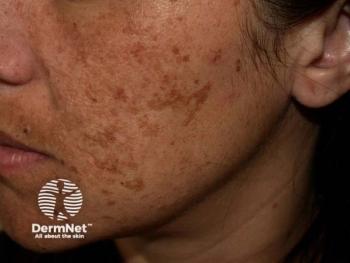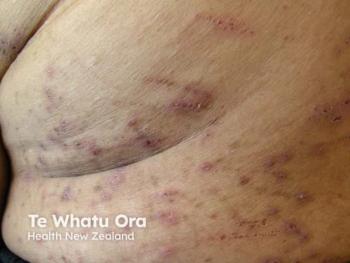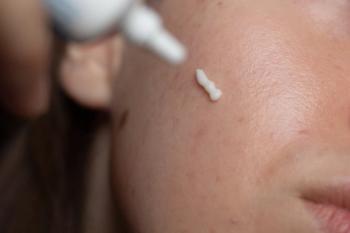
- Dermatology Times, Putting Progress Into Practice for Patients With Vitiligo, August 2025 (Vol. 46. Supp. 04)
- Volume 46
- Issue 04
Vitiligo Management in Practice: Expert Case Reviews
Key Takeaways
- The roundtable event explored vitiligo treatment strategies, focusing on case presentations and the psychosocial impact of the disease.
- Limited access to phototherapy necessitates reliance on topical and systemic agents, with discussions on treatment responsiveness and adherence.
Ted Lain, MD, MBA, moderated a Case-Based Roundtable event to discuss diverse case presentations of vitiligo and how to build a treatment regimen.
“Sharing that in an open forum like this—where no one is right or wrong, and there’s no judgment—was a way for us to hear different viewpoints and options. I think we all took those home and will apply those to our practice," said Ted Lain, MD, MBA, after an exclusive
Lain, chief medical officer at Sanova Dermatology in Austin, Texas, moderated an insightful and engaging discussion with fellow peers to discuss diverse case presentations of vitiligo and how to build a treatment regimen. Lain guided attendees through 3 complex patient cases, highlighting differences in disease severity, comorbidities, psychosocial impact, and treatment history.
Case No. 1
In the first case, Lain presented a young adult patient with vitiligo affecting the cheeks, forearms, and hands, with initial stability followed by noticeable spread. The challenge involved how to initiate treatment—particularly topical therapy—in a patient newly motivated to seek care, with visible lesions contributing to emotional distress and reduced quality of life.
During the exam, erythema within the patient’s lesions raised the possibility of an inflammatory subtype, prompting attendees to discuss treatment responsiveness.
“We weren’t sure how that would affect his response to treatment—whether it’s inflammatory, not stable, or progressive,” Lain said. “There are various different articles to support the idea that each one is more resistant than the other, so it’s really difficult to say.”
Attendees also considered follicular density and how that influences repigmentation success.
“We knew that this patient, while just starting treatment on his face, might get a better response than on his arms, and how that may affect his [adherence],” he added.
Lain also highlighted a major theme: limited access to phototherapy.
“Most of us don’t have full-body units anymore, or if they are available, the coverage from payers is horrible,” Lain said. “So we really have to lean into the different topicals and/or systemic agents that are available to us.”
Case No. 2
The second case explored how to manage rapidly progressing vitiligo in a woman with moderate body surface area involvement and underlying autoimmune disease. Among attendees, the case sparked conversation about systemic and combination therapy approaches, the role of phototherapy, and how to guide patients through a long-term management plan grounded in disease stabilization.
Lain emphasized the difficulty of treatment when vitiligo spreads quickly and affects high-friction or hard-to-reach areas such as the elbows and back.
“This kind of patient rang a bell with many of us,” Lain said. “Without the use of full-body narrowband [UVB], we started thinking about what we would do systemically in addition to topical therapy.”
Potential systemic options discussed included pulse oral corticosteroids, off-label Janus kinase (JAK) inhibitors, and other immunosuppressants aimed at halting disease activity.
“The treatment is a marathon and not a sprint,” Lain said. “It will—and possibly could—take many, many months to years for her to see repigmentation to the point that she’s kind of content with the results.”
Attendees also considered the psychological toll of lesions on visible or friction-prone areas and how both clinical and quality-of-life considerations must shape treatment conversations.
Case No. 3
The final case focused on the challenges of managing vitiligo in adolescents, a population in which visible lesions often intersect with high psychosocial vulnerability. Clinicians examined the need for family-centered care, appropriate treatment selection, and clear expectation setting to support young patients navigating both physical symptoms and emotional hurdles. Lain also emphasized the psychosocial dimension of pediatric vitiligo.
“This was a really unfortunate presentation,” he said. “Again, the psychosocial aspect of it came through, and perhaps the need to refer for child psychology to help with coping mechanisms.”
Lain walked attendees through a conversation on balancing disease control with minimizing treatment burden in this age group. Systemic agents and pulse corticosteroids were discussed cautiously, with a strong preference for shared decision-making and gentle topical options.
“It’s a shared model of determining what’s the right path forward,” Lain said. “We present the data, we present our options, and let the patient and her parents really work through those themselves.”
Given the sensitive location of lesions and tolerability concerns, ruxolitinib stood out as a leading candidate.
“Topical calcineurin inhibitors often sting and burn, and especially younger patients seem to be more susceptible to that,” Lain noted. “So the topical JAK inhibitor…ruxolitinib came into play here.”
The pediatric case reinforced the need for empathy, education, and individualized care plans that address the emotional and clinical realities of growing up with vitiligo.
Therapeutic Momentum
Through all 3 cases, clinicians expressed strong enthusiasm for evolving vitiligo treatment strategies, particularly in light of new therapeutic options and emerging long-term data. From topical innovations such as ruxolitinib to practical guidance on phototherapy and systemic agents, discussions reflected a dynamic exchange of real-world experience and evidence-based insight.
Lain noted attendees' collaborative atmosphere and willingness—many early-career dermatologists—to share perspectives and practical insights.
“I was really impressed with the level of engagement we had.… They felt very comfortable giving their ideas in front of their peers and having a conversation,” he said.
That openness created space for rich clinical discussion and peer learning.
“Sharing that in an open forum like this—where no one is right or wrong, and there’s no judgment—was a way for us to hear different viewpoints and options for treatment,” Lain added. “And I think we all took those home and will apply those to our practice.”
Articles in this issue
Newsletter
Like what you’re reading? Subscribe to Dermatology Times for weekly updates on therapies, innovations, and real-world practice tips.


















